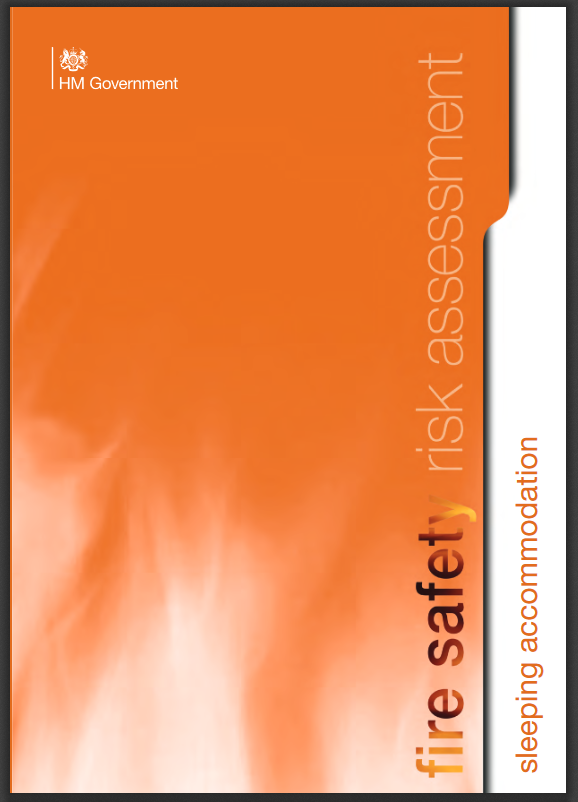
‘Responsible Person’ – Fire Safety Law – Sleeping Accommodation
Guidance for Responsible Persons:
How to use the guide
This guide is divided into two parts:
Part 1
Explains what fire risk assessment is and how you might go about it. Fire risk assessment should be the foundation for all the fire precautions in your premises.
Part 2
Provides further guidance on fire precautions. The information is provided for you and others to dip into during your fire risk assessment or when you are reviewing your precautions.
The appendices provide example checklists, some detailed technical information on fire-resisting elements and advice on historic buildings.
This guide is one from a series of guides listed on the back cover.
The rest of this introduction explains how the law applies.
Technical terms are explained in the glossary and references to other publications listed at the end of the publication are identified by a superscript number in the text.
In this Guide reference is made to British Standards and standards provided by other bodies. The standards referred to are intended for guidance only and other standards could be used. Reference to any particular standard is not intended to confer a presumption of conformity with the requirements of the Regulatory Reform (Fire Safety) Order 2005 (the Order).
The level of necessary safety (or service) must be dictated by the findings of your risk assessment so you may need to do more or less than that specified in any particular standard referred to. You must be prepared to show that what you have done complies with any requirements or prohibitions of the Order irrespective of whether you have relied on a particular standard.
A full list of references can be found at the back of the downloaded book.
Published for HM Government under licence from the Controller of Her Majesty’s Stationery Office.
© Crown Copyright 2006
All rights reserved.
ISBN 978 185112817 4
You may re-use this document/publication (not including logos) free of charge in any format or medium, under the terms of the Open Government Licence v3.0. To view this licence, visit nationalarchives.gov.uk/doc/open-government-licence/version/3 or write to the Information Policy Team, The National Archives, Kew, Richmond, Surrey TW9 4DU; or email: psi@nationalarchives.gsi.gov.uk.
Originally published by the Department for Communities and Local Government, reprinted (from previous artwork supplied) by The Stationery Office, January 2015
This publication is available at www.gov.uk/government/publications
Printed in the United Kingdom for The Stationery Office
J3026753 C1 04/15
This guide is for all employers, managers and owners of premises providing sleeping accommodation. Details of other guides in the series are listed on the back cover. It tells you about how you might comply with fire safety law, helps you to carry out a fire risk assessment and identify the general fire precautions you need to have in place.
It has been written to provide guidance for a responsible person, to help them to carry out a fire risk assessment in less complex premises. If you read the guide and decide that you are unable to apply the guidance, then you should seek expert advice from a competent person. More complex premises will probably need to be assessed by a person who has comprehensive training or experience in fire risk assessment. However this guide can be used for multi-occupied buildings to address fire safety issues within their individual occupancies.
DOWNLOAD THE GUIDE - PDF
Fire safety is only one of many safety issues which management must address to minimise the risk of injury or death to staff or the public. Unlike most of the other safety concerns, fire has the potential to injure or kill large numbers of people very quickly. This guidance is concerned only with fire safety but many of the measures discussed here will impact upon other safety issues, and vice versa. It is recognised that these various differing safety demands can sometimes affect one another and management should consult other interested agencies (e.g. Local Authority) where necessary to confirm that they are not contravening other legislation/guidance.
THE FIRE SAFETY ORDER
Previous general fire safety legislation:
The Order replaces previous fire safety legislation. Any fire certificate issued under the Fire Precautions Act 1971 will cease to have any effect. If a fire certificate has been issued in respect of your premises or the premises were built to recent building regulations, as long as you have made no material alterations and all the physical fire precautions have been properly maintained, then it is unlikely you will need to make any significant improvements to your existing physical fire protection arrangements to comply with the Order. However, you must still carry out a fire risk assessment and keep it up to date to ensure that all the fire precautions in your premises remain current and adequate. If you have previously carried out a fire risk assessment under the Fire Precautions (Workplace) Regulations 1997, as amended 1999, and this assessment has been regularly reviewed then all you will need to do now is revise that assessment taking account of the wider scope of the Order as described in this guide. If your premises are an HMO, flat or maisonette they will also be subject to the Housing Act 2004. Further information regarding the scope of the Housing Act can be found by contacting your local housing authority.
Background
The Order applies in England and Wales. It covers general fire precautions and other fire safety duties which are needed to protect ‘relevant persons’ in case of fire in and around most ‘premises’. The Order requires fire precautions to be put in place ‘where necessary’ and to the extent that it is reasonable and practicable in the circumstances of the case. Responsibility for complying with the Order rests with the ‘responsible person’. In a workplace, this is the employer and any other person who may have control of any part of the premises, e.g. the manager or owner. In all other premises the person or people in control of the premises will be responsible. If there is more than one responsible person in any type of premises (e.g. a multi-occupied complex), all must take all reasonable steps to co-operate and co-ordinate with each other. If you are the responsible person you must carry out a fire risk assessment which must focus on the safety in case of fire of all ‘relevant persons’. It should pay particular attention to those at special risk, such as disabled people, those who
you know have special needs and children, and must include consideration of any dangerous substance liable to be on the premises. Your fire risk assessment will help you identify risks that can be removed or reduced and to decide the nature and extent of the general fire precautions you need to take.
If your organisation employs five or more people, your premises are licensed or an alterations notice is in force, you must record the significant findings of the assessment. It is good practice to record your significant findings in any case.
You MUST:
♦ appoint one or more competent persons, depending on the size and use of your premises, to assist in undertaking any of the preventive and protective measures required by the Order (you can nominate yourself for this purpose). A competent person is someone with enough training and experience or knowledge and other qualities to be able to implement these measures properly.
♦ provide your employees with clear and relevant information on the risks to them identified by the fire risk assessment, about the measures you have taken to prevent fires, and how these measures will protect them if a fire breaks out.
♦ consult your employees (or their elected representatives) about nominating people to carry out particular roles in connection with fire safety and about proposals for improving the fire precautions.
♦ before you employ a child, provide a parent with clear and relevant information on the risks to that child identified by the risk assessment, the measures you have put in place to prevent/protect them from fire and inform any other responsible person of any risks to that child arising from their undertaking.
♦ inform non-employees, such as residents, temporary or contract workers, of the relevant risks to them, and provide them with information about who are the nominated competent persons, and about the fire safety procedures for the premises.
♦ co-operate and co-ordinate with other responsible persons who also have premises in the building, inform them of any significant risks you find and how you will seek to reduce/control those risks which might affect the safety of their employees.
♦ provide the employer of any person from an outside organisation who is working in your premises (e.g. an agency providing temporary staff) with clear and relevant information on the risks to those employees and the preventive and protective measures taken. You must also provide those employees with appropriate instructions and relevant information about the risks to them.
If you are not the employer but have any control of premises which contain more than one workplace, you are also responsible for ensuring that the requirements of the Order are complied with in those parts over which you have control.
♦ consider the presence of any dangerous substances and the risk this presents to relevant persons from fire.
♦ establish a suitable means of contacting the emergency services and provide them with any relevant information about dangerous substances.
♦ provide appropriate information, instruction and training to your employees, during their normal working hours, about the fire precautions in your workplace, when they start working for you, and from time to time throughout the period they work for you.
♦ ensure that the premises and any equipment provided in connection with firefighting, fire detection and warning, or emergency routes and exits are covered by a suitable system of maintenance and are maintained by a competent person in an efficient state, in efficient working order and in good repair.
♦ co-operate with you to ensure the workplace is safe from fire and its effects, and must not do anything that will place themselves or other people at risk.
Cautionary Note: -
Guidance is not prescriptive - the Responsible Person MUST be competent!
The ICM is is open for professionals who need to consider their own competence in Fire Risk Management at all levels and to provide independent expert assessment and certification under ISO9001 standards to be appropriately Registered - ICM Registration requires subscription ICM membership to then gain access all essential CPD updates ...
Ed.
